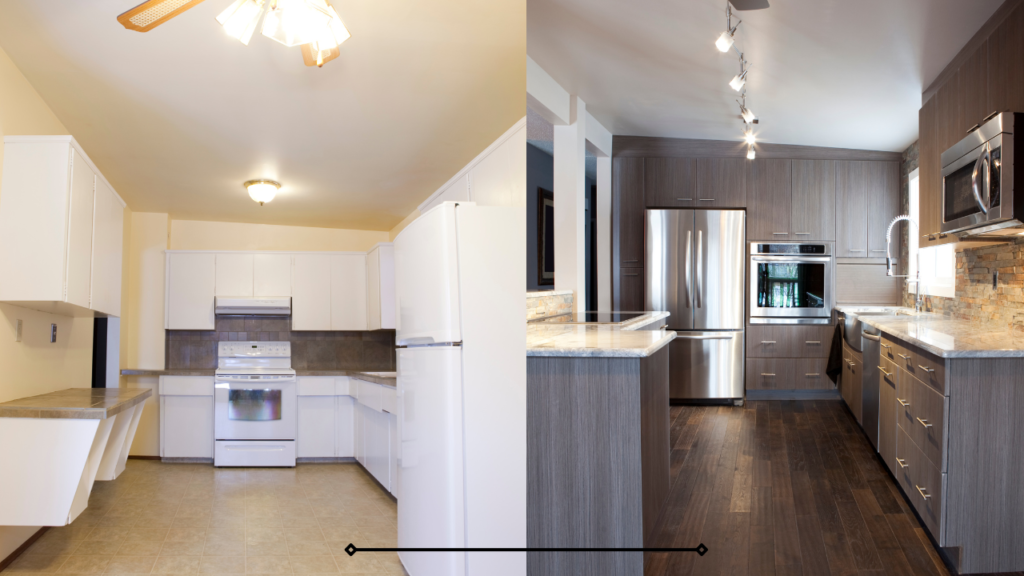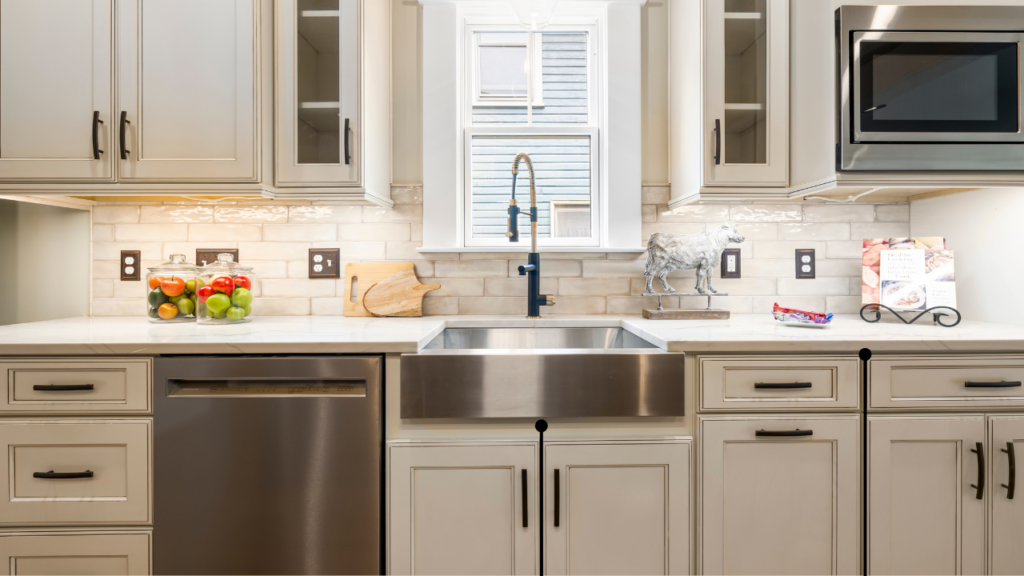You just spent time scrubbing your kitchen cabinets, expecting them to feel smooth and fresh—but instead, they’re still sticky. Frustrating, right? Why Are My Kitchen Cabinets Sticky After Cleaning? This is a common problem, and it often comes down to leftover grease, improper cleaning techniques, or residue from cleaning products.
I’ve been there too—wiping, scrubbing, even trying DIY tricks that seemed promising but left me with the same stubborn stickiness. So, what’s going on? In this guide, I’ll break down why this happens and, more importantly, how to fix it. Stick around for expert tips that work!
Why Are My Kitchen Cabinets Sticky After Cleaning?
You just cleaned your kitchen cabinets, expecting them to feel fresh and smooth—but instead, they’re still sticky. What gives? It’s frustrating, but you’re not alone. This happens to a lot of people, and the reason is usually leftover grease, cleaning product residue, or even the wrong cleaning method.
Grease is sneaky. Even if your cabinets look clean, a thin layer of oil from cooking can build up over time. When you wipe them down, some of that grease mixes with your cleaner and spreads around instead of fully coming off. If you use a cleaner that leaves a residue or doesn’t rinse properly, that stickiness lingers.
What Causes the Stickiness?
Ever cleaned your kitchen cabinets, only to have them still feel sticky? It’s annoying, right? You’re not alone—this happens more often than you’d think. The culprit? It usually comes down to the wrong cleaning products, grease buildup, or improper cleaning techniques. Let’s break it down.
Using the Wrong Cleaning Products
Not all cleaners are cabinet-friendly. Some leave behind a residue that makes the surface feel tacky instead of clean. Ever sprayed a cleaner, wiped it down, and felt like the surface was almost… worse? That’s because some products contain oils, waxes, or soap-based ingredients that don’t fully evaporate. Over time, this residue builds up, trapping dust and making your cabinets feel grimy.
Grease Buildup
Cooking releases tiny grease particles into the air. They land on your cabinets, mix with dust, and form a stubborn, sticky film. If you don’t clean it off regularly, it layers up. The worst part? When you finally try to scrub it away, the grease sometimes just spreads instead of lifting off.
Improper Cleaning Techniques
Sometimes, it’s not what you clean with, but how you clean. Using too much water can actually spread grease around, while not rinsing properly can leave behind a sticky residue. Another common mistake? Scrubbing too hard with abrasive materials, which can damage the finish and make grease stick even more.

How to Clean Grease-Off Kitchen Cabinets
Grease on kitchen cabinets is like that one guest who overstays their welcome—it clings on and refuses to leave. But don’t worry, I’ve got you covered! The first step? Knowing what kind of cabinets you’re dealing with.
Wooden vs. Laminate Cabinets
Not all cabinets are created equal. Wood is porous, meaning grease can seep in over time, making it trickier to clean. Laminate, on the other hand, has a smooth, sealed surface, so grease sits on top rather than sinking in. That means the cleaning approach needs to match the material.
Cleaning Greasy Wooden Cabinets
Wood needs a gentle touch—you don’t want to strip the finish or cause damage. Here’s a simple and effective way to clean it:
- Mix a safe cleaner: Combine equal parts white vinegar and warm water in a spray bottle. (Vinegar cuts through grease like a pro!)
- Spray and wipe: Lightly mist the cabinets and wipe with a microfiber cloth. Don’t drench the wood—too much moisture can cause damage.
- For stubborn spots: Make a baking soda paste (baking soda + a little water), apply it to the sticky area, and gently scrub with a soft sponge.
- Dry it well: Always follow up with a dry cloth to prevent moisture from soaking into the wood.
Cleaning Greasy Laminate Cabinets
Laminate is easier to clean but still needs the right approach. Try this:
- Use dish soap: A few drops of grease-cutting dish soap in warm water works wonders.
- Wipe with a soft cloth: Avoid abrasive scrubbers, as they can scratch the surface.
- Rinse and dry: Wipe again with a damp cloth to remove any soap residue, then dry with a clean towel.
How to Remove Grease from Wooden Kitchen Cabinets
Wooden cabinets are beautiful, but they need extra care—especially when grease is involved. Unlike laminate, wood is porous, meaning grease doesn’t just sit on the surface. It seeps in, making it harder to clean and leaving behind that annoying sticky feel.
But don’t worry! You don’t need harsh chemicals to fix it. Here are some easy, effective ways to get rid of grease while keeping your cabinets looking great.
DIY Natural Solutions
If you prefer natural cleaners, these simple ingredients do the trick:
- Vinegar & Water: Mix equal parts white vinegar and warm water in a spray bottle. Lightly mist the cabinets and wipe with a microfiber cloth. (Vinegar breaks down grease like magic!)
- Baking Soda Paste: For tougher spots, make a paste with baking soda and a little water. Apply it to the sticky areas and gently scrub with a soft sponge.
- Dish Soap & Warm Water: A few drops of grease-cutting dish soap in warm water work wonders. Use a damp cloth to wipe, then dry immediately to avoid moisture damage.
Best Store-Bought Cleaners for Wooden Cabinets
If DIY isn’t your thing, look for cleaners labeled “safe for wood” and “grease-cutting.” Some good options include:
- Murphy’s Oil Soap – A trusted, gentle cleaner that removes grease while nourishing wood.
- Method Wood Cleaner – Plant-based and effective without leaving residue.
- Weiman Cabinet & Wood Cleaner – Designed to cut grease and restore shine without damaging the finish.
How to Prevent Future Grease Buildup
The best way to fight grease? Stop it before it sticks! Here’s how:
- Wipe Cabinets Regularly: A quick wipe with a damp cloth after cooking prevents grease from building up.
- Use a Protective Sealant: Applying a wood-safe polish or sealant creates a barrier against grease and stains.
- Keep a Grease Trap: If you fry food often, use a splatter guard or keep a grease-catching mat near the stove.
With the right cleaning routine, you can keep your wooden cabinets looking fresh, grease-free, and beautiful for years to come!
How to Prevent Sticky Cabinets After Cleaning
So, you’ve finally tackled those stubborn greasy cabinets, and they’re looking fresh and clean. But how do you keep them that way? Let’s talk about how to prevent sticky buildup so you don’t have to scrub like crazy every time.
Routine Cleaning: How Often Should You Clean Your Cabinets?
Here’s the deal—kitchen cabinets get dirty faster than you think. Cooking releases tiny grease particles that float through the air and land on your cabinets. Even if you don’t fry food often, steam, dust, and daily use can lead to a sticky mess over time.
If you cook daily, a quick wipe with a damp microfiber cloth every couple of days helps keep grease from settling in. A deeper clean every month with a gentle degreaser will ensure your cabinets stay smooth and fresh.
Best Cleaning Techniques to Avoid Stickiness
Even the best cleaning products won’t help if you’re using the wrong techniques. Here are some simple tricks to make sure your cabinets stay clean without that annoying sticky residue:
- Use a dry cloth first: Before applying any cleaner, wipe your cabinets with a dry microfiber cloth to remove dust and loose debris. This prevents dirt from turning into a greasy paste when mixed with cleaning products.
- Choose the right cleaner: Avoid oil-based or soap-heavy cleaners that leave behind residue. A simple solution of warm water and a few drops of dish soap works wonders.
- Don’t oversaturate: Too much liquid can leave streaks and even damage wooden cabinets over time. Lightly dampen your cloth instead of soaking it.
- Always wipe dry: After cleaning, go over your cabinets with a dry cloth to remove excess moisture and prevent residue buildup. This also helps maintain the finish and keeps them looking polished.
Regular Maintenance Tips: How to Protect Cabinets from Grease Buildup
Prevention is easier than deep cleaning, so let’s talk about how to stop grease and grime from taking over in the first place.
- Wipe After Cooking – Get in the habit of quickly wiping down cabinets near the stove after frying or boiling. A warm, damp cloth works great for catching fresh grease before it hardens.
- Use a Cabinet Sealant or Polish – For wooden cabinets, applying a light coat of wood polish or a natural wax helps create a protective barrier against grease and stains.
- Keep Your Kitchen Well-Ventilated – Use an exhaust fan or open windows while cooking to reduce airborne grease.
- Line the Inside of Cabinets – If you store cooking oils or sauces in your cabinets, place liners or paper towels underneath to catch drips and prevent sticky messes.
- Try a DIY Grease Repellent – A mix of one part vinegar and one part water can act as a mild grease deterrent. Lightly mist your cabinets once a week and wipe them down to keep buildup at bay.
By following these simple tips, you’ll keep your cabinets looking clean and fresh without the frustration of constant deep cleaning. A little regular maintenance goes a long way, and your future self will thank you!

Frequently Asked Questions (FAQs)
What’s the best product to remove grease from kitchen cabinets?
The best product for cutting through stubborn grease depends on your cabinet material and preference for natural or commercial cleaners. For a natural solution, a simple mix of white vinegar and warm water works wonders—vinegar breaks down grease without leaving residue. If you prefer a store-bought cleaner, Murphy’s Oil Soap is excellent for wooden cabinets, while Krud Kutter Degreaser or Dawn Dish Soap mixed with warm water can handle laminate cabinets.
How often should I clean my kitchen cabinets to avoid stickiness?
A quick wipe-down once a week keeps grease from building up. If you cook frequently, especially with oil or butter, a light cleaning every few days prevents stubborn grime. A deep clean once a month using a degreaser or mild soap ensures long-term maintenance. Think of it like brushing your teeth—you wouldn’t wait until there’s plaque buildup to start cleaning!
Can I use dish soap to clean my kitchen cabinets?
Yes! Dish soap is one of the best degreasers out there. A few drops of grease-cutting dish soap like Dawn in warm water can lift away grease without damaging the finish. Just make sure to wipe with a damp cloth afterward to remove any soapy residue. If your cabinets still feel sticky, go over them again with a vinegar-water solution or a dry microfiber cloth.
How do I prevent future grease buildup on wooden kitchen cabinets?
Prevention is key! Here’s what helps:
- Wipe down cabinets regularly—A quick wipe with a microfiber cloth after cooking removes fresh grease before it hardens.
- Use a protective sealant—Applying a wood-safe polish or wax creates a barrier against grease and stains.
- Improve ventilation—Using an exhaust fan while cooking prevents grease from settling on cabinets.
- Line cabinet shelves—If you store cooking oils inside cabinets, place paper towels or shelf liners underneath to catch drips. A little maintenance goes a long way in keeping your cabinets looking fresh!
Why is my kitchen cabinet still sticky after cleaning with vinegar?
If your cabinets are still sticky after using vinegar, it’s likely due to layered grease buildup or residue from previous cleaners. Vinegar is great for breaking down fresh grease, but for older, thicker buildup, try a baking soda paste (mix baking soda with a little water) and gently scrub with a soft cloth. If the stickiness persists, a stronger degreaser like Krud Kutter or diluted dish soap may be needed. Also, always rinse and dry thoroughly after cleaning—leftover moisture can create a tacky feeling.
Conclusion
So, there you have it! Sticky kitchen cabinets are a common frustration, but with the right knowledge and tools, they don’t have to be a headache. Whether it’s leftover grease, residue from cleaning products, or a few common cleaning mistakes, the causes behind the stickiness are easier to tackle than they seem.
The key is to use the right cleaners—stick to gentle, grease-cutting solutions—and always dry your cabinets properly after cleaning. For wooden cabinets, avoid over-wetting and use soft cloths to protect that beautiful finish. And remember, regular maintenance and a little preventative care go a long way in keeping your cabinets looking fresh.
If you’re still battling sticky surfaces, don’t be afraid to dive into some deeper cleaning methods or even consider a professional. But most importantly, don’t let the frustration get to you—this is a fixable problem!

I’m a writer and culinary expert with over 10 years of experience in the kitchen. As a graduate of the Institute of Culinary Education and a passionate home chef, I created KitchenBreez.com to share my knowledge of kitchen techniques, cooking tips, and the best kitchen gadgets. Whether you’re a seasoned cook or just starting, my goal is to help you make your time in the kitchen more efficient and enjoyable.
